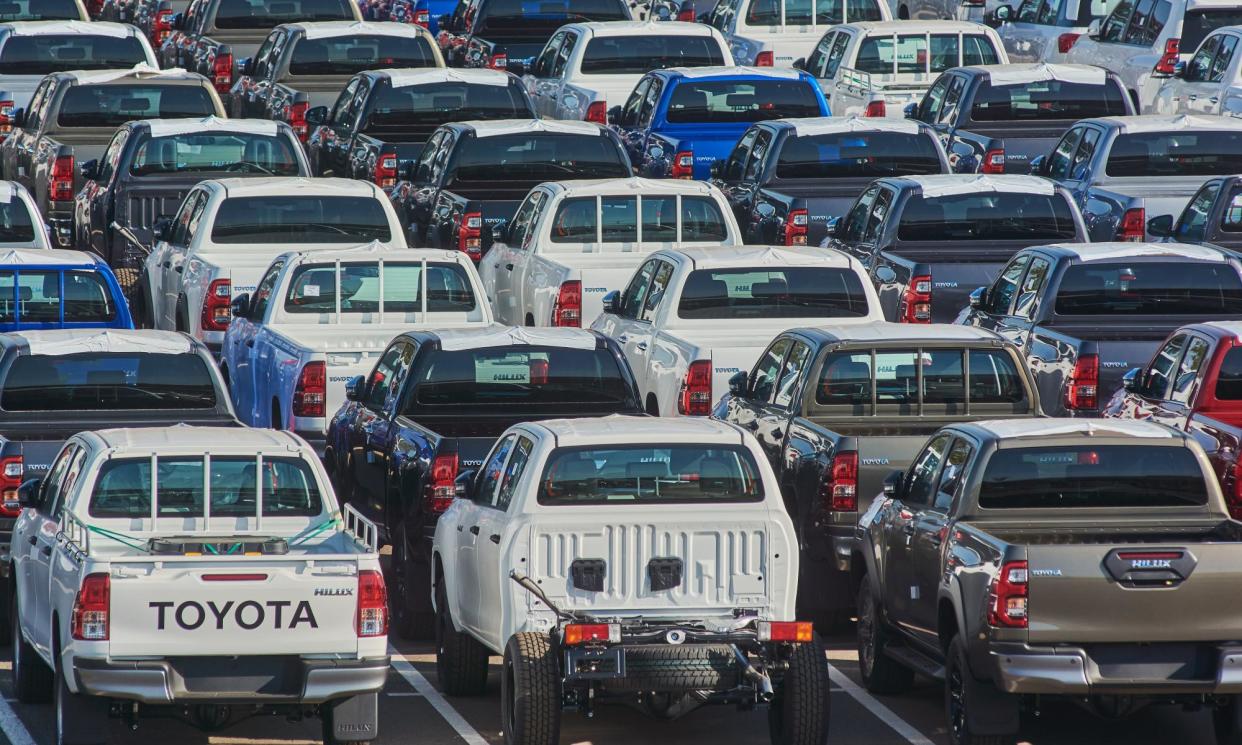Toyota asks for Australia’s proposed vehicle emissions standard to be watered down

Toyota has asked the Albanese government to water down its proposed new laws aimed at disincentivising the purchase of the worst polluting cars and hastening the importation of cleaner vehicles.
Australia’s biggest selling brand – which makes popular models such as the HiLux and LandCruiser – has voiced concerns the scheme will harm rural and regional drivers.
Toyota, in its submission to the government responding to the unveiling of its preferred model for the national vehicle efficiency standard (NVES) in early February, said it was broadly supportive of such a scheme, but made a raft of recommendations, including asking it to “revisit (the) stringency” of targets set out in its preferred “option B” model.
Toyota’s submission comes as rival manufacturers continue sparring with one another as well as climate advocates over claims the proposed NVES will increase the cost of popular car types and is too strict for the industry.
Australia’s proposed fuel standard will place a cap on the emissions from new cars to incentivise carmakers to supply low- and zero-emissions vehicles. The cap will be lowered over time.
Companies whose emissions averages come in below the cap will gain credits, which can be used by other companies who will be penalised for exceeding the cap.
The government plans to introduce legislation before July that will take effect from January 2025.
The Albanese government’s preferred model is expected to cut 369m tonnes of CO2 by 2050 – equivalent to the last six years of emissions from light vehicles in Australia.
The company noted how the proposed NVES is loosely based on targets under the scheme in place in the US, and pointed to media reports from recent weeks citing unnamed sources that Joe Biden was considering softening certain tailpipe emissions reductions targets to 2030 in part due to pressure during an election year.
“Reports indicate that the USA intends to decelerate the implementation of its annual emissions requirements and review the applicable timeframes,” Toyota’s submission said. “Evidence from the USA market shows that there has been a ‘slower than anticipated demand for electric vehicles’.”
Toyota – which made three of Australia’s top 10 selling cars in 2023 and had come under criticism for taking until last week to introduce its first electric vehicle to the Australian market – also called for the introduction of penalties outlined in the proposed NVES model to be staggered.
While the government has proposed a $100 per g/km of CO2 rate of penalty when the scheme comes into effect as planned for January 2025, Toyota said this was “too severe” and would risk costing consumers.
Related: Anthony Albanese flatly denies claim Thai PM asked for slowing of fuel efficiency standards
Instead, it wants there to be no financial penalties for manufacturers exceeding their caps in the first two years of the scheme. It then wants the penalty amount to increase in yearly phases, staggered to reach a penalty rate of $100 per g/km by 2029.
Toyota also asked for the government to tweak the credit scheme in its preferred model by incorporating different types of credits carmakers can earn.
Currently, “supercredits” for the cleanest of vehicles, “off-cycle credits” for specific green technologies used in cars that are not measured in tailpipe emissions, and “air conditioning credits” for using greener refrigerants, only feature in the least ambitious NVES model being considered, but not preferred, by the government.
Echoing concerns made by the federal opposition, Toyota also warned of potential specific downsides for regional and rural Australians requiring specific higher polluting car types for their road conditions as opposed to others who could choose cleaner alternatives.
“Given Australia’s unique conditions, vehicles need to be developed to a higher severity rating which require ladder frame chassis to navigate Australian roads which inherently increases vehicle mass (adding up to 300kg).
“The target setting of Option B unfairly penalises the vehicles that everyday regional and rural Australian conditions require. Across industry, Option B as presented will negatively impact the consumers who need rather than want these products,” the company said.
Toyota also backed in the position of the Federal Chamber of Automotive Industries (FCAI), the industry body whose campaigning against the government’s preferred NVES model has seen Tesla and Polestar quit the group in protest with accusations it was not representing them and was making unsubstantiated claims the scheme would increase the cost of cars.
Meanwhile, the Grattan Institute submission on the proposed NVES model estimated the policy would on average increase prices by about 1%, but that consumers would quickly be financially better off due to significant savings on fuel and maintenance costs.
Australia remains one of the few countries in the OECD without standards. Industry analysts have routinely warned that manufacturers are treating Australia as a dumping ground for heavily polluting vehicles due to a lack of penalties.
A new car sold in Australia uses, on average, 6.9 litres of fuel for each 100km compared with new cars in Europe and the US that use 3.5 litres and 4.2 litres, respectively.


